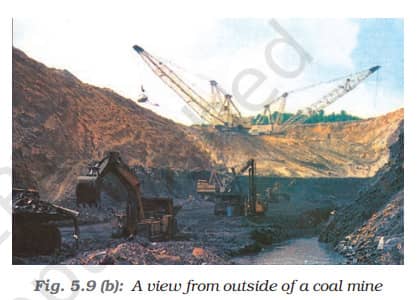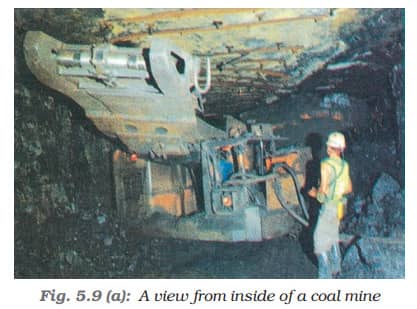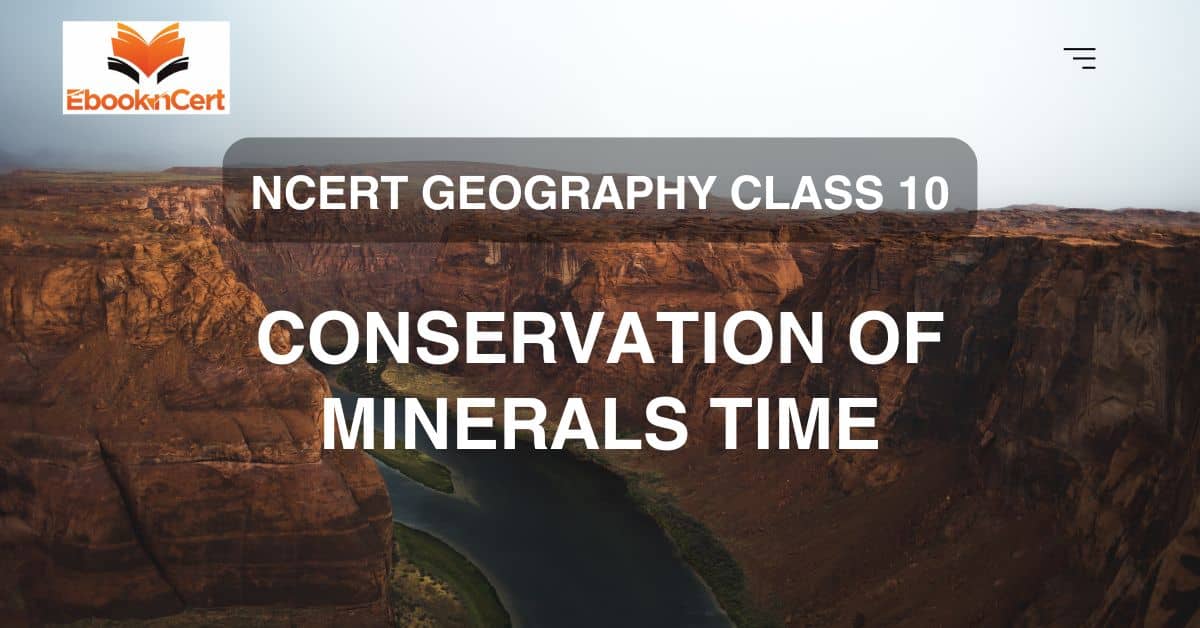NCERT Geography Class 10 | Conservation Of Minerals
Topic & sub-topics covered: Conservation Of Minerals and MCQs Questions: Minerals and Energy Resources (All single detail notes are exam-oriented).
We have discussed in-depth and exam-oriented pointers that can be asked in the board exam of class 10th about “Conservation Of Minerals” from the NCERT Geography notes for class 10th chapter 5th “Minerals and Energy Resources“.
Download the NCERT Geography for Class 10th Chapter 5 Minerals and Energy Resources PDF Notes
NCERT Geography Class 10th Chapter 5 – Minerals and Energy Resources
Complete your Geography preparation for your board exam or any examinations for NCERT Geography Class 10 Chapter 5: Minerals and Energy Resources PDF Notes! This chapter dives deep into the types, distribution, and uses of various minerals and energy resources, the Occurrence Of Minerals, and the Conservation Of Minerals that are essential for human development. With explanations that are easy to understand for any student and key points highlighted, these notes are ideal for exam preparation and quick revisions. Simplify your study process with this comprehensive resource. Download the PDF now and stay ahead in your Class 10 Geography journey!
Conservation Of Minerals
1. Dependence on Minerals:
- Industries and agriculture are heavily reliant on mineral deposits.
- Workable mineral deposits form only 1% of the Earth’s crust.
- Mineral resources are finite and non-renewable.
- Geological processes of mineral formation are slow, making replenishment rates negligible.
- Continuous extraction leads to higher costs and declining quality of ores.
2. Sustainable Use of Minerals:
- Planned and sustainable resource usage is essential.
- Technologies for using low-grade ores at reduced costs need to be developed.
- Recycling metals and using substitutes conserve mineral resources.
3. Energy Resources:
- Energy is essential for cooking, lighting, heating, transportation, and industrial machinery.
- Energy sources are classified as:
a. Conventional sources: Coal, petroleum, natural gas, firewood, cattle dung cake, hydel, and thermal electricity.
b. Non-conventional sources: Solar, wind, tidal, geothermal, biogas, atomic energy.
4. Coal:


- India’s most abundant fossil fuel, meeting substantial energy needs.
- Forms of coal:
a. Peat: Low carbon, high moisture, low heating capacity.
b. Lignite: Low-grade brown coal; reserves in Neyveli, Tamil Nadu.
c. Bituminous coal: Most used commercially; high-grade variant used in iron smelting.
d. Anthracite: Highest quality, hard coal. - Coal deposits:
a. Gondwana coal: Found in Damodar, Godavari, Mahanadi, Son, and Wardha valleys.
b. Tertiary coal: Found in Meghalaya, Assam, Arunachal Pradesh, Nagaland.
5. Petroleum:
- The second major energy source in India.
- Provides fuel, lubricants, and raw materials for industries like textiles, fertilizers, and chemicals.
- Petroleum occurrences:
a. Found in anticlines, fault traps, and porous rocks (limestone/sandstone).
b. Major production areas: Mumbai High, Gujarat, Assam.
6. Natural Gas:
- Found with petroleum deposits; used in various industries and as domestic fuel.
- Emerging as a preferred fuel for transport (CNG) and homes (PNG).
- Major reserves: Mumbai High, Cambay basin, Krishna-Godavari basin.
- Infrastructure: The HVJ pipeline links western and northern India.
7. Electricity:
- Index of development due to wide applications.
- Generated in two ways:
a. Hydro electricity: Renewable, generated by flowing water.
b. Thermal electricity: Generated using fossil fuels like coal, petroleum, and natural gas.
8. Non-Conventional Sources of Energy:
- Importance due to fossil fuel shortages and environmental concerns.
- Examples: Solar, wind, tidal, biomass, geothermal energy.
- India’s largest renewable energy programmes include solar and wind power.
9. Nuclear Energy:
- Generated using uranium and thorium.
- Major reserves: Jharkhand, Rajasthan (Aravalli), Monazite sands in Kerala.
- Six nuclear power stations in India.
10. Solar Energy:
- India’s tropical location provides abundant solar energy potential.
- Applications: Rural and remote areas to reduce dependence on firewood and dung cakes.
11. Wind Energy:
- High potential in India.
- Major wind farm clusters: Tamil Nadu, Gujarat, Karnataka, Maharashtra, Kerala, Lakshadweep.
12. Biogas:
- Produced from organic waste; it is efficient compared to kerosene and dung cakes.
- Gobar gas plants benefit farmers by providing energy and manure.
13. Tidal Energy:
- Generated using oceanic tides with floodgate dams.
- Potential sites: Gulf of Khambhat, Gulf of Kutch, Gangetic delta in Sunderbans.
14. Geothermal Energy:
- Utilizes Earth’s internal heat.
- High geothermal gradient areas: Parvati Valley (Himachal Pradesh), Puga Valley (Ladakh).
Conservation of Energy Resources
1. Energy and Economic Development:
- Energy is essential for economic development.
- Sectors requiring energy:
a. Agriculture
b. Industry
c. Transport
d. Commercial
e. Domestic - Economic development plans since Independence have increased energy demand.
- Energy consumption is steadily rising across the country.
2. Need for Sustainable Energy Development:
- A sustainable energy development path is essential due to rising energy demands.
- Twin strategies for sustainability:
a. Energy conservation
b. Increased use of renewable energy sources
3. Energy Efficiency in India:
- India is among the least energy-efficient countries globally.
- Judicious use of energy resources is critical due to their limited availability.
4. Citizen’s Role in Energy Conservation:
- Measures for energy conservation:
a. Use public transport instead of personal vehicles.
b. Switch off electricity when not in use.
c. Use power-saving devices.
d. Opt for non-conventional energy sources. - The principle: “Energy saved is energy produced.”
Next & Previous Topics of NCERT/CBSE Geography Class 10 Chapter 5: Minerals and Energy Resources
| Topics No. | Topics Name |
|---|---|
| 1 | Introduction To Minerals and Energy Resources |
| 2 | Mode of Occurrence of Minerals |
| 3 | Conservation of Minerals |
MCQ Questions on NCERT Geography Class 10 Chapter 5 | Conservation Of Minerals
Question 1. What percentage of the Earth’s crust is made up of workable mineral deposits?
a) 10%
b) 5%
c) 1%
d) 15%
Answer: c) 1%
Question 2. Why are mineral resources considered non-renewable?
a) They are renewable only in certain conditions.
b) The geological process of their formation is very slow.
c) They are renewable but require high costs.
d) They are abundant and easy to replenish.
Answer: b) The geological process of their formation is very slow.
Question 3. Which among the following is a suggested step for conserving mineral resources?
a) Increasing extraction rates
b) Recycling of metals
c) Stopping mining activities completely
d) Increasing reliance on non-renewable resources
Answer: b) Recycling of metals
Question 4. Which of the following is NOT a conventional source of energy?
a) Firewood
b) Solar energy
c) Coal
d) Petroleum
Answer: b) Solar energy
Question 5. What percentage of rural households in India meet their energy needs through firewood and cattle dung cake?
a) 50%
b) 60%
c) 70%
d) 80%
Answer: c) 70%
Question 6. Which energy source is considered renewable?
a) Petroleum
b) Coal
c) Hydro-electricity
d) Natural gas
Answer: c) Hydro-electricity
Question 7. Which type of coal has the highest carbon content and heating capacity?
a) Lignite
b) Peat
c) Bituminous
d) Anthracite
Answer: d) Anthracite
Question 8. Where are principal lignite reserves located in India?
a) Assam
b) Tamil Nadu
c) Jharkhand
d) Rajasthan
Answer: b) Tamil Nadu
Question 9. Which coalfield is NOT located in the Damodar Valley?
a) Jharia
b) Raniganj
c) Bokaro
d) Neyveli
Answer: d) Neyveli
Question 10. Petroleum is typically found in which type of geological formations?
a) Gondwana rocks
b) Anticlines and fault traps
c) Igneous rocks
d) Floodplains
Answer: b) Anticlines and fault traps
Question 11. Which is the oldest oil-producing state in India?
a) Gujarat
b) Assam
c) Maharashtra
d) Tamil Nadu
Answer: b) Assam
Question 12. Which pipeline was the first cross-country gas pipeline in India?
a) HBJ Pipeline
b) HVJ Pipeline
c) KG Basin Pipeline
d) Mumbai-Gujarat Pipeline
Answer: b) HVJ Pipeline
Question 13. Where are India’s major gas reserves located?
a) Cauvery Basin
b) Mumbai High
c) Rajasthan
d) Vindhyan Basin
Answer: b) Mumbai High
Question 14. Which of the following is a renewable source of electricity generation?
a) Thermal power
b) Nuclear power
c) Hydro-electricity
d) None of the above
Answer: c) Hydro-electricity
Question 15. Which multipurpose project produces hydroelectric power in India?
a) HVJ Pipeline
b) Bhakra Nangal
c) Digboi Refinery
d) Damodar Valley Corporation
Answer: b) Bhakra Nangal
Question 16. Which Indian state has the largest wind farm cluster?
a) Gujarat
b) Tamil Nadu
c) Maharashtra
d) Kerala
Answer: b) Tamil Nadu
Question 17. What is the main input for generating biogas?
a) Petroleum waste
b) Cattle dung and organic waste
c) Coal
d) Uranium
Answer: b) Cattle dung and organic waste
Question 18. Which of the following is a practice for conserving energy?
a) Using individual vehicles more
b) Using power-saving devices
c) Avoiding the use of public transport
d) Increasing electricity consumption
Answer: b) Using power-saving devices
Question 19. Which slogan promotes energy conservation?
a) “Energy saved is energy wasted.”
b) “Energy saved is energy produced.”
c) “Consume to conserve.”
d) “More energy, more progress.”
Answer: b) “Energy saved is energy produced.”
Question 20. What is the twin plank of sustainable energy?
a) Use of fossil fuels and energy imports
b) Promotion of energy conservation and renewable sources
c) Development of nuclear power and coal-based industries
d) Hydropower generation and increasing thermal power plants
Answer: b) Promotion of energy conservation and renewable sources
Question 21. What happens as mineral extraction increases?
a) Costs decrease and quality improves
b) Costs increase and quality decreases
c) Quality improves but costs remain constant
d) Both costs and quality remain constant
Answer: b) Costs increase and quality decreases
Question 22. Which of the following technologies can help conserve mineral resources?
a) Enhanced mining operations
b) Use of low-grade ores at low costs
c) Expanding mineral exportation
d) Increasing fossil fuel usage
Answer: b) Use of low-grade ores at low costs
Question 23. Which type of coal is known as “low-grade brown coal”?
a) Bituminous
b) Anthracite
c) Lignite
d) Peat
Answer: c) Lignite
Question 24. Which state has significant lignite reserves?
a) Jharkhand
b) Tamil Nadu
c) Assam
d) Maharashtra
Answer: b) Tamil Nadu
Question 25. Which valley contains major Gondwana coal reserves?
a) Godavari Valley
b) Damodar Valley
c) Brahmaputra Valley
d) Krishna Valley
Answer: b) Damodar Valley
Question 26. Where are tertiary coal deposits mainly found?
a) West Bengal
b) North-eastern states
c) Gujarat
d) Maharashtra
Answer: b) North-eastern states
Question 27. What is the main function of petroleum refineries?
a) Generate Electricity
b) Supply coal to industries
c) Act as a nodal industry for various products
d) Purify natural gas
Answer: c) Act as a nodal industry for various products
Question 28. Which is a major petroleum production area in Gujarat?
a) Digboi
b) Ankleshwar
c) Naharkatiya
d) Moran
Answer: b) Ankleshwar
Question 29. Which region of India is known for its offshore petroleum fields?
a) East Coast
b) West Coast
c) Southern Plateau
d) Himalayan region
Answer: b) West Coast
Question 30. What is the full form of the HVJ pipeline?
a) Hazira-Vizag-Jodhpur
b) Hazira-Vijaipur-Jagdishpur
c) Hyderabad-Vijayawada-Jamnagar
d) Hosur-Valapadi-Jalgaon
Answer: b) Hazira-Vijaipur-Jagdishpur
Question 31. Which basin on the East Coast is a new reserve of natural gas?
a) Cauvery Basin
b) Krishna-Godavari Basin
c) Ganga Basin
d) Mahanadi Basin
Answer: b) Krishna-Godavari Basin
Question 32. Which type of electricity generation is non-renewable?
a) Hydro-electricity
b) Solar power
c) Thermal power
d) Wind power
Answer: c) Thermal power
Question 33. What is considered an index of development?
a) Per capita income
b) Per capita consumption of electricity
c) Per capita mineral extraction
d) Per capita fossil fuel usage
Answer: b) Per capita consumption of electricity
Question 34. Which region in India is known for tidal energy potential?
a) Gangetic plains
b) Gulf of Khambhat
c) Vindhyan range
d) Western Ghats
Answer: b) Gulf of Khambhat
Question 35. Which renewable energy source is generated by decomposing organic matter?
a) Tidal energy
b) Geothermal energy
c) Biogas
d) Solar energy
Answer: c) Biogas
Question 36. What is a significant characteristic of geothermal energy?
a) Produced from tidal flows
b) Uses the Earth’s internal heat
c) Depends on sunlight
d) Derived from wind energy
Answer: b) Uses the Earth’s internal heat
Question 37. Which state is home to the Parvati Valley geothermal energy project?
a) Jammu & Kashmir
b) Himachal Pradesh
c) Uttarakhand
d) Ladakh
Answer: b) Himachal Pradesh
Question 38. Which of the following is a measure to promote energy conservation?
a) Increasing fossil fuel consumption
b) Using public transport
c) Avoiding power-saving devices
d) Building more thermal plants
Answer: b) Using public transport
Question 39. What is India’s position in terms of energy efficiency globally?
a) Among the most energy-efficient countries
b) Among the least energy-efficient countries
c) At an average level of energy efficiency
d) Unranked globally
Answer: b) Among the least energy-efficient countries
Question 40. Which non-conventional energy source is highly suitable for remote and rural areas in India?
a) Hydro-electricity
b) Solar energy
c) Nuclear energy
d) Petroleum
Answer: b) Solar energy

